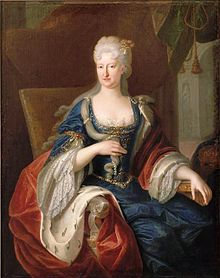
The House of Habsburg (, German: Haus Habsburg, pronounced[haʊ̯sˈhaːpsˌbʊʁk], also known as the House of Austria, is one of the most prominent and important dynasties in European history.
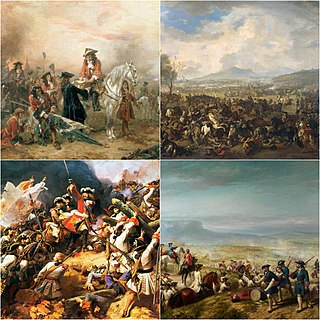
The War of the Spanish Succession was a European great power conflict fought between 1701 and 1714. The immediate cause was the death of the childless Charles II of Spain in November 1700, which led to a struggle for control of the Spanish Empire. His nominated heir was Philip of Anjou, a grandson of Louis XIV of France, whose main backers were France and most of Spain. His rival, Archduke Charles of Austria, was supported by the Grand Alliance, whose primary members included the Holy Roman Empire, the Dutch Republic, and Great Britain. Significant related conflicts include the 1700 to 1721 Great Northern War, and Queen Anne's War in North America.
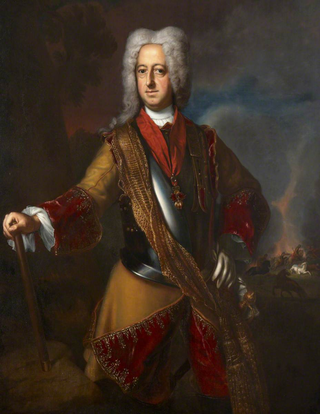
Maximilian II, also known as Max Emanuel or Maximilian Emanuel, was a Wittelsbach ruler of Bavaria and a Prince-elector of the Holy Roman Empire. He was also the last governor of the Spanish Netherlands and Duke of Luxembourg. An able soldier, his ambition led to conflicts that limited his ultimate dynastic achievements.
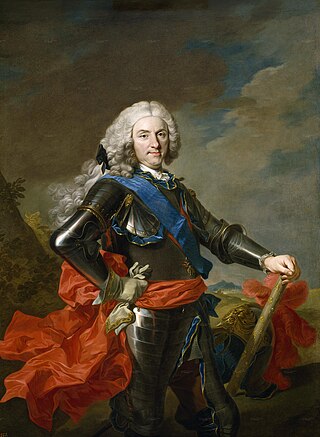
Philip V was King of Spain from 1 November 1700 to 14 January 1724 and again from 6 September 1724 to his death in 1746. His total reign is the longest in the history of the Spanish monarchy, surpassing Philip II. Philip V instigated many important reforms in Spain, most especially the centralization of power of the monarchy and the suppression of regional privileges, via the Nueva Planta decrees, and restructuring of the administration of the Spanish Empire on the Iberian Peninsula and its overseas regions.

Charles VI was Holy Roman Emperor and ruler of the Austrian Habsburg monarchy from 1711 until his death, succeeding his elder brother, Joseph I. He unsuccessfully claimed the throne of Spain following the death of his relative, Charles II. In 1708, he married Elisabeth Christine of Brunswick-Wolfenbüttel, by whom he had his four children: Leopold Johann, Maria Theresa, Maria Anna, and Maria Amalia.

Charles II became the last Habsburg ruler of Spain at the age of three in 1665. Now best remembered for his physical disabilities, and the War of the Spanish Succession that followed his death, his reign is generally viewed as one of managed decline. However, many of the issues pre-dated him, and the Spanish Empire remained largely intact at his death.

Joseph Ferdinand Leopold of Bavaria was the son of Maximilian II Emanuel, Elector of Bavaria and his first wife, Maria Antonia of Austria, daughter of Leopold I, Holy Roman Emperor, maternal granddaughter of King Philip IV of Spain.
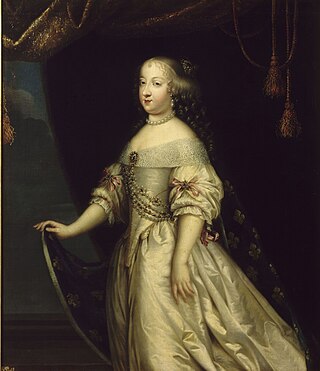
Maria Theresa of Spain was Queen of France from 1660 to 1683 as the wife of King Louis XIV. She was born an Infanta of Spain and Portugal as the daughter of King Philip IV and Elisabeth of France, and was also an Archduchess of Austria as a member of the Spanish branch of the House of Habsburg.

The Treaty of London (1700) or Second Partition Treaty was the second attempt by Louis XIV of France and William III of England to impose a diplomatic solution to the issues that led to the 1701-1714 War of the Spanish Succession. Both divided the Spanish Empire without prior consultation and since the Spanish viewed an undivided Empire as non-negotiable, historians generally view them as largely unenforceable.
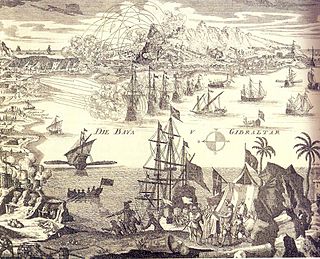
The Treaty of Seville was signed on 9 November 1729 between Britain, France, and Spain, formally ending the 1727–1729 Anglo-Spanish War; the Dutch Republic joined the Treaty on 29 November.
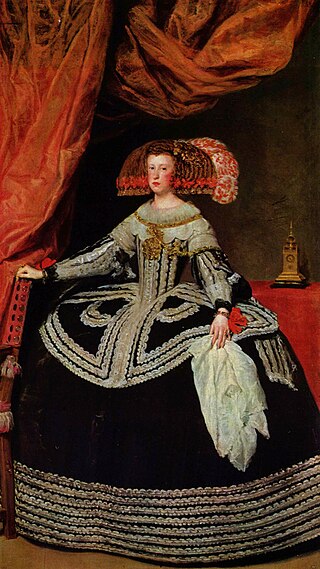
Mariana or Maria Anna of Austria,, was Queen of Spain from 1649, when she married her uncle Philip IV of Spain, until his death in 1665. She was then appointed regent for their three-year-old son Charles II, and due to his ill health remained an influential figure until she died in 1696.

The 1731 Treaty of Vienna was signed on 16 March 1731 between Great Britain and Emperor Charles VI on behalf of the Habsburg monarchy, with the Dutch Republic included as a party.

The 1720 Treaty of The Hague was signed on 17 February 1720 between Spain and the Quadruple Alliance, established by the 1718 Treaty of London. Its members included Britain, France, the Dutch Republic and Austria.
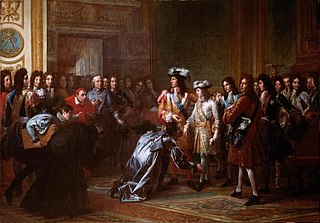
The Treaty of Den Haag, or Treaty of The Hague, was signed on 7 September 1701 between England, the Holy Roman Emperor Leopold I, and the United Provinces. It reconstituted the 1689 anti-French Grand Alliance in response to the issues that resulted in the War of the Spanish Succession.

The 1698 Treaty of The Hague, also known as the 1698 Treaty of Den Haag or First Partition Treaty was one of two attempts by France, Great Britain, and the Dutch Republic to achieve a diplomatic solution to the issues that led to the 1701–1714 War of the Spanish Succession.

Maria Anna Josepha of Austria was an Austrian archduchess who became Electoral Princess of the Palatinate as the wife of Johann Wilhelm, Elector Palatine.

After the death of the last Habsburg monarch of Spain in 1700, the childless Charles II, the Spanish throne was up for grabs between various dynasties of Europe despite Charles having left a will naming his heir. In this will, Charles left Philip, Duke of Anjou, grandson of Louis XIV of France, the possessions of the Spanish Crown.

Marie Louise d'Orléans was Queen of Spain as the wife of King Charles II. She was born petite-fille de France as the daughter of Philippe I, Duke of Orléans and Princess Henrietta of England. Marie became the Queen of Spain on 19 November 1679, and remained in her post until her death in 1689 from the presumed cause of appendicitis.

The imperial election of 1742 was an imperial election held to select the emperor of the Holy Roman Empire. It took place in Frankfurt on January 24. The result was the election of Charles Albert of Bavaria, the first non-Habsburg emperor in hundreds of years.
